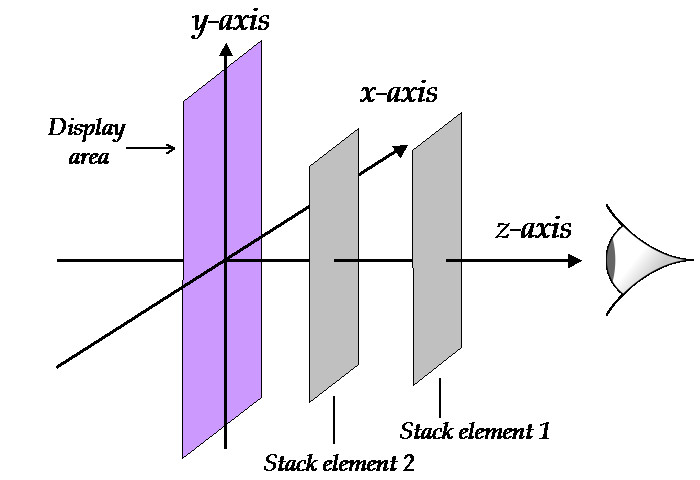前言
2020 秋天,我將用 30 天的時間,來嘗試回答和網路前端開發相關的 30 個問題。30 天無法一網打盡浩瀚的前端知識,有些問題可能對有些讀者來說相對簡單,不過期待這趟旅程,能幫助自己、也幫助讀者打開不同的知識大門。有興趣的話,跟著我一起探索吧!
在上一篇文章當中,談到了 Block Formatting Context,除此之外,我們也知道有其他的 formatting context 像是
等等,這些 context 定義了當中的 elements 會如何「排列」。不過到目前為止,上面所談到的「排列」,指的是在二維平面上的排列,實際上當瀏覽器在渲染畫面的時候,還會考慮到第三個維度,也就是 z 軸的順序,來決定如何渲染。
可以想像一個網頁畫面的寬與高,分別代表了 x 與 y 軸,而 z 軸則是垂直於網站,指向使用者。也就是說,如果一個 element 的 z 軸的值越高,那麼就代表越接近使用者,也會遮擋住 z 軸值較低的 element

同時,我們也知道在 CSS 當中,有一個 z-index 的屬性,可以讓我們決定 elements 之間彼此的重疊狀況。
於是,就讓我們馬上來試試看如何操作 z-index。首先,先建立了兩個 block elements,然後為了製造重疊的效果,我透過負的 margin 讓下面的 Box-2 往上移動進而擋住了 Box-1。
最後,我嘗試使用 z-index ,讓 Box-1 可以跑到 Box-2 的前面,也是不會被遮蓋住。
<!-- html -->
<div>
<div class="box box-1">Box-1</div>
<div class="box box-2">Box-2</div>
</div>
/* css */
.box {
width: 100px;
height: 100px;
color: white;
text-align: center;
}
.box-1 {
z-index: 2; /* 期待將 div 移動到較上層 */
background: green;
}
.box-2 {
z-index: 1; /* 期待將 div 移動到較下層 */
background: blue;
margin: -50px 0 0 25px;
}

結果發現,一點效果也沒有。原因是 z-index 只會作用在 position 屬性不為 static 的 elements 上,所以只要將 CSS 改為
/* css */
.box {
width: 100px;
height: 100px;
color: white;
text-align: center;
position: fixed; /* 新增這行 */
}
.box-1 {
z-index: 2;
background: green;
}
.box-2 {
z-index: 1;
background: blue;
margin: -50px 0 0 25px;
}

Box-1 跑到前面來了!不過這裡我是把 position: fixed 同時加入到兩個 boxes,也就是 .box 當中,如果只加到 .box-1 當中也會有同樣的效果,但是如果只加到 .box-2 當中,則就沒有效果。
另一方面,如果我們不加入 position ,而是加入 opacity 在 .box-1 當中,結果出現
/* css */
.box {
width: 100px;
height: 100px;
color: white;
text-align: center;
}
.box-1 {
z-index: 2;
background: green;
opacity: 0.9; /* 新增這行 */
}
.box-2 {
z-index: 1;
background: blue;
margin: -50px 0 0 25px;
}

會發現 box-1 就這樣神奇地出現在前面了!為什麼會這樣子呢?
答案是
原本 box-1 和 box-2 都在相同的 stacking context 當中,後出現的 element 自然會排在前面。然而當我們在 box-1 加上
opacity屬性之後,box-1 自己會建立一個全新的 stacking context,而這個 stacking context 出現在原先的 (root) stacking context 之後,所以就自然會排在前面!
Stacking context 是一個告訴當中的 elements 該如何堆疊的環境,其實規則也很簡單,就是在 HTML 文件當中,後出現的 elements,會排在先出現的 elements 前面,也就是 z 軸的值較大,較接近使用者。
然而,在一個網頁當中,並不是所有的 elements 都存在在同一個 stacking context。這裡的概念,跟先前提到的 Block formatting context 很像。在某些條件下,element 會創造出新的 formatting context,並套用在它所有的後代元素上。
根據 MDN,會創造出新的 stacking context 的常見的條件有:
當 HTML 文件建立的時候,就會自動生成一個 context(要不然所有東西都不知道如何堆疊了)。另外,只要有設定上述的 position 與 z-index 條件,也會產生新的 context。這也就是剛剛的例子當中的第一種解法。
還有其他條件,像是創造出 flex 或是 grid 的 context,本身就會同時建立新的 stacking context:
另外一個比較特別的,是關於 opacity 的設定,也就是剛剛的例子當中的第二種解法,也會產生新的 stacking context
還有其他許多條件,這裡就先不多談了。只要有新的 stacking context 被建立,這個 context 當中的 element 的 z-index 就只會和在同一個 context 下的 element 進行比較。
也就是說,在 z 軸方向較為下面的 stacking context 當中的 element 不管 z-index 有多大,都無法超越較為上面的 context 當中的 element。
舉例來說,回到剛剛的例子,如果分別在兩個 boxes 中間加入 sub-box,並將 box-2 當中的 sub-box 的 z-index 設定為 9999
<!-- html -->
<div class="container">
<div class="box box-1">Box-1
<div class="subbox box-1-1">Box-1-1</div>
</div>
<div class="box box-2">Box-2
<div class="subbox box-2-1">Box-2-1</div>
</div>
</div>
/* css */
.box {
width: 100px;
height: 100px;
color: white;
text-align: center;
}
.box-1 {
z-index: 2;
background: green;
opacity: 0.99; /* 建立出新的 stacking context*/
}
.box-2 {
z-index: 1;
background: blue;
margin-top: -50px;
margin-left: 25px;
}
.subbox {
width: 100px;
height: 25px;
background: red;
}
.box-2-1 {
z-index: 9999; /* 再高的值都不會跑到 box-1 之上*/
}

會發現一點效果也沒有,因為 box-1 和 box-2 已經在不同的 stacking context 當中。
看到這裡,希望不要覺得世界好像很複雜。最後這裡整理一下關於 stacking 順序的判斷條件
z-index: 0 的位置z-index 為負值,則會跑到基準點後面。也就是會跑到建立這個 context 的 element 的後面。z-index,則會依照出現的順序堆疊:後出現在 z 軸較上方的位置。z-index 為正值,那麼 z 軸高度都會高於第 4 點當中所有的 elements。突然發現前端頁面是個充滿不同 "context" 的環境,如果能夠正確理解這些 "context",就可以避免掉一些小錯誤囉。
TD
Be curious as astronomer, think as physicist, hack as engineer,
fight as baseball player
More about me"Life is like riding a bicycle. To keep your balance, you must keep moving."
